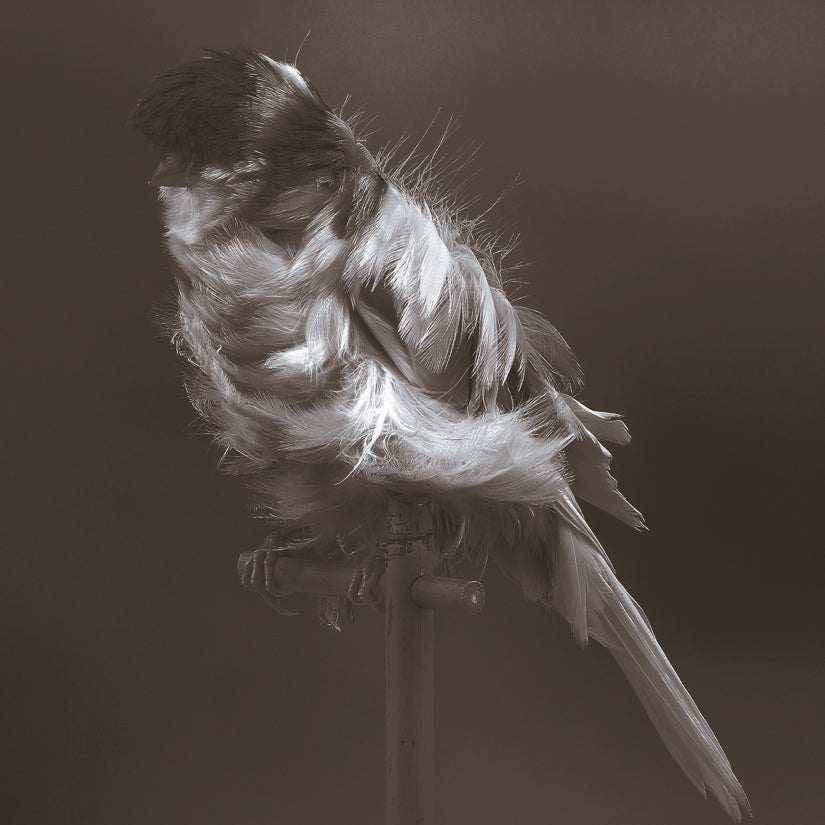GLOSSSARY
DIBOND
In this face mounting process, a photograph is mounted on a same-size, composite panel made of aluminum, meaning that it is glued on to a surface so that the edges of both photograph and plate are even. The even application of special glue produces a lasting, smooth surface. To prevent damage, the photograph is then protected by a UV laminate.
BARYTA PRINT
This is a general term, in frequent use in Germany, for the classic black-and-white print on fiber-based, silver halide photographic paper. Raw photo paper is coated with a thin layer of baryta (barium sulfate), which prevents the emulsion from being completely absorbed into the paper. This intensifies the blacks and whites, creating a high-definition image with a strong contrast between light and shadow. Surfaces can range from glossy to extremely matte. (BVDG: Bundesverband Deutscher Galerien, Cologne)
C-PRINT
A general term for a color coupler print that has at least three coats of light-sensitive silver salts emulsion. After processing, the silver image is removed by a fixer, so that only the “coupled” colors formed in the layer remain. (BVDG: Bundesverband Deutscher Galerien, Cologne)
DIASEC
Diasec is a patented name for a process in which a photograph is sealed between a panel (usually aluminum) and an acrylic glass plate. This special seal protects the photograph from UV rays, climate changes, and chemical air pollution, which makes the print extremely durable. In addition, the acrylic glass enhances the illusion of depth, thanks to the way it bonds with the picture without refracting light.
DIGITAL PIGMENT PRINT
In digital photography, the image is not captured on film, but on a light-sensitive chip, which in turn transforms the image into data and saves it in a proper storage medium. Analog photos can also be digitally processed, but most digital photos come from digital still cameras, videos, camcorders, and different kinds of scans. Digitalizing an image with digital processing software allows for a wide variety of ways to optimize and shape the image. Besides the traditional processing techniques, such as brightening underexposures, retouching, and improving color contrast, a photographer has access to all of the computer graphics techniques that make it practically impossible for the human eye to spot alterations. Furthermore, digitally stored images can often be printed over and over, without any loss of quality. At this point in time, the ink jet print and the laser print (Lambda print) are of special interest on the fine arts photography market, since these prints are durable and of good quality. (artnet fotoglossar)
GICLÉE
A high-end reproduction of a work of art made on an inkjet printer is called a giclée. The printing method allows for the finest gradations in tonal values and excellent detail, and is done with UV-resistant pigment inks on sturdy, layered, archive-quality art paper.
ORIGINAL
From a purely technical standpoint, every photograph printed from a negative onto photographic paper, whether by hand or machine, is an original photo. In the strictest sense, or from an authorial standpoint, however, an original is a print personally made by the photographer, or else by a photo technician selected by the photographer. Due to the possibilities involved in technical reproduction, a photographic original is not necessarily one of a kind. Since the nineteen-seventies, at the latest, many fine arts photographers have been issuing numbered editions of prints, in the same way that fine arts prints are issued. Every print in a limited edition issued by the artist is an original. There are no rules in Germany regulating the number of prints that may be in an edition. As far as old photographs are concerned, museums and art dealers use the term “vintage print” as a synonym for an original photograph.
SEPIA PRINT
To make a sepia print, a “normally” processed print is treated (sometimes years later) in a toner bath. The toner does not affect the gelatin or the paper, but the silver, which creates the image. This makes the image last longer, too, because even though the elementary silver in a photo oxidizes over the years, it is more stable because the toning changes the pure metallic silver into a silver compound.
SILVER GELATIN OR GELATIN SILVER PRINT
This process produces precisely detailed, brilliant images, and so, throughout the twentieth century and onward, it has been the process most frequently employed to make black-and-white prints. Light-sensitive silver salts or crystals are the basic element used to create a photograph. Silver imbedded in gelatin makes a suspension, which is then used to coat the photo paper. When exposed to light, metallic silver atoms are freed and form a latent image (primary photographic process). During the next step, development, the silver particles can be seen as grains or density, and together they form the motif of the photograph. Bathing the print in fixer removes the undeveloped silver salts.
VINTAGE
Vintages or vintage prints are prints that were made right around the time the photograph was taken—that is, when the negative was created. Among collectors, the vintage print is considered the most valuable type of photographic “original.”
DELUXE EDITION
A Deluxe or Luxury edition is a part of the normal edition of a publication, which is 'made' with an intervention of the artist himself or herself and whose edition is (usually) limited. The artist's signature on the front endpaper or a handwritten addition, a quotation, a drawing, a numbering indicating the total edition (e.g., 'This is expl. no. 3 of a total of 100 expl.') can distinguish the special edition from the standard edition, and often - and especially in the field of photo books - a signed original print by the (photo)artist is included with the publication. Some artists manipulate the book cover design and provide a limited number of books from the normal publisher's edition with an individually designed cover, thus creating a special incentive for collectors. If it is a more elaborate, smaller edition using special techniques, it is referred to as an → edition (which is then usually also more expensive and is only made available in a significantly smaller number of pieces).
EMAILLLE
As the French term for the material also known as enamel, is a composition of inorganic components brought together by a melting process. However, this melting process is stopped just before its peak, resulting in a glassy mass. The substances that make up the enamel before melting are usually from the group of silicates and oxides. After the first melting, the enamel is brought to temperature a few more times and after a short heating, the firing, it is fixed to the substrate. Enamel often serves in a protective function of preserving metal or glass, which in these cases make up the substrate. Enamel works always have a high-quality and artistic character. They are found since the European Middle Ages in (sacral) art objects as well as (later) in products of industrial production. Enamel protects metal from corrosion, so it has a practical use, but it can also be used specifically for artistic purposes, especially when colored oxides are used in the process. Both aspects come into play especially in jewelry making.
FINE ART PRINT
Also known as -> Giclée printing (from the French gicler = to splash), this printing process involves applying high-quality pigment inks to archival-strength fine papers - in contrast to the dye inks used for ordinary prints. Fine Art Prints are light-resistant and of the highest (museum) quality, fading or 'shifting' of the colors is impossible even after years. This is how photo prints become pieces of art that last for generations.
MONOTYPE
The monotype is in hand printing process that produces only unique pieces. To create a monotype, the artist applies ink or paint directly to a glass, acrylic or metal plate. The image is then transferred from the plate to the backing paper either by manual pressure or a printing press. To apply color selectively, the artist can use masks to leave areas between the paper and plate free for further color application. This gradually creates a multi-layered print. Most of the ink or color is removed from the surface after the first press-on. The remainder is usually insufficient to leave a new impression. For this reason, the image created in monotype printing is unique. With subsequent prints, the image becomes much weaker and you get a so-called 'ghost print', which is practically impossible to trade.
SILK PRINTING
Silk printing, also known as → Serigraphy or Screenprinting in the field of art graphics, is a through-printing process in which the printing ink is printed with a rubber squeegee through a frame covered with fine-mesh fabric, the screen. The mesh is made partially impermeable by manual masking with stencils, by direct painting, or by a photochemical process. One screen must be made for each printing color, so that in the case of multicolor screen printing, the complete motif only becomes visible after several printing processes. Different tonal values can be achieved by using transparent colors printed on top of each other or by using a screen structure. The high flexibility of the process and the durability of the printing ink make screen printing a popular technique that many artists have worked with time and again and still do today.
MODERN PRINT
Modern Print does not refer to a technique, but to a duplication module: This duplication method means producing a modern photographic print from a historical negative. The print is then marked in the description with two different dates of origin, the date of the photograph itself and the date of the (modern) print. It’s a given possibility to make available and keep historical photo testimonies available in modern times.



